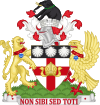
Hatton Garden is a street and commercial zone in the Holborn district of the London Borough of Camden, abutting the narrow precinct of Saffron Hill which then abuts the City of London. It takes its name from Sir Christopher Hatton, a favourite of Queen Elizabeth I, who established a mansion here and gained possession of the garden and orchard of Ely Place, the London seat of the Bishops of Ely. It remained in the Hatton family and was built up as a stylish residential development in the reign of King Charles II. For some decades it often went, outside of the main street, by an alternative name St Alban's Holborn, after the local church built in 1861.

A costermonger, coster, or costard is a street seller of fruit and vegetables in British towns. The term is derived from the words costard and monger (seller), and later came to be used to describe hawkers in general. Some historians have pointed out that a hierarchy existed within the costermonger class and that while costermongers sold from a handcart or animal-drawn cart, mere hawkers carried their wares in a basket.

The Camden markets are a number of adjoining large retail markets, often collectively referred to as Camden Market or Camden Lock, located in the historic former Pickfords stables, in Camden Town, London. It is situated north of the Hampstead Road Lock of the Regent's Canal. Famed for their cosmopolitan image, products sold on the stalls include crafts, clothing, bric-a-brac, and fast food. It is the fourth-most popular visitor attraction in London, attracting approximately 250,000 people each week.

Broadway Market is a street in the London Borough of Hackney, best known for the street market held there. Licences to trade are issued by a committee of councillors from Hackney London Borough Council.
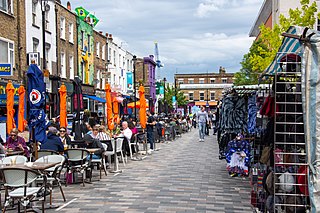
Inverness Street Market is an outdoor street market in Camden, North London. Licences to trade are issued by Camden London Borough Council.
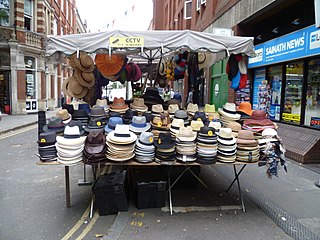
Earlham Street Market is a street market in situated in the Seven Dials area of Covent Garden on a short road between Shaftesbury Avenue and Monmouth Street. Licences to trade are issued by Camden London Borough Council.

Kirkgate Market is a market complex on Vicar Lane in the city centre of Leeds, West Yorkshire, England. It is the largest covered market in Europe and a Grade I listed building. There are currently 800 stalls which attract over 100,000 visitors a week.
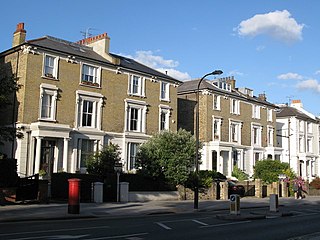
Haverstock is an area of the London Borough of Camden: specifically the east of Belsize Park, north of Chalk Farm and west of Kentish Town. It is centred on Queens Crescent and Malden Road. Gospel Oak is to the north, Camden Town to the south.

Queen's Crescent Market is an outdoor street market held every Thursday and Saturday on Queen's Crescent in Kentish Town, Camden between the junction with Malden Road in the West and the junction with Grafton Road in the East. Licences to trade are issued by Camden London Borough Council.
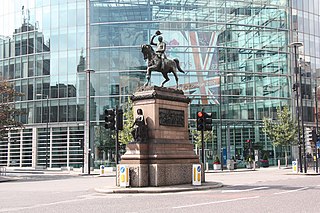
Holborn Circus is a five-way junction at the western extreme of the City of London, specifically between Holborn and its Hatton Garden part. Its main, east–west, route is the inchoate A40 road. It was designed by the engineer William Haywood and opened in 1867. The term circus describes how the frontages of the buildings facing curved round in a concave chamfer. These, in part replaced with glass and metal-clad buildings, remain well set back.

Norwich Market is an outdoor market consisting of around 200 stalls in central Norwich, England. Founded in the latter part of the 11th century to supply Norman merchants and settlers moving to the area following the Norman conquest of England, it replaced an earlier market a short distance away. It has been in operation on the present site for over 900 years.

Saffron Hill, Hatton Garden, Ely Rents and Ely Place was a liberty and from 1866 to 1930 a civil parish in the metropolitan area of London, England. It was part of the ancient parish of St Andrew Holborn.

Whitechapel Road market, also known as Whitechapel Market is a long-established historic London outdoor street market managed by the London Borough of Tower Hamlets which is centered on the A11 thoroughfare of the same name in Whitechapel in the East End of London, next to Whitechapel station and is the focus point of the Whitechapel Market Conservation Area that was set up in 1997 and extended in 2008.

Maltby Street Market is a weekly street-food and provisions market in Bermondsey, southeast London, England. The market is located on a street of the same name near Tower Bridge in the old Horselydown parish of Bermondsey.

Chalton Street Market is a street market in Camden, North London.
Street trading is selling from a stall, stand, or vehicle in the street rather than in a market hall or square. A collection of regular, and adjacent, street traders forms a street market. Where traders operate on their own, from a regular location, these are variously described as isolated pitches, scattered sites, or miscellaneous sites. Peripatetic traders are termed pedlars.

Plender Street Market is an outdoor street market in Camden, North London. Licences to trade are issued by Camden London Borough Council.

Goodge Place Market is an outdoor street market in Fitzrovia, in the London Borough of Camden. Licences to trade are issued by Camden London Borough Council.

Swiss Cottage Market is an outdoor street market in Camden, North London. Licences to trade are issued by Camden London Borough Council.




















